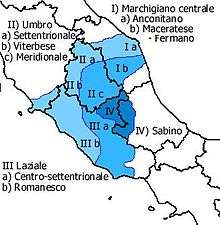Sabino dialect
| Sabino | |
|---|---|
| Aquilano, Reatino, Cicolano. | |
| Native to | Italy |
| Region | Lazio (provinces of Rieti, Rome), Northern Abruzzo (province of Aquila) |
| Language codes | |
| ISO 639-3 | – |
| Glottolog |
cico1238 Cicolano-Reatino-Aquilano[1] |
 | |
Sabino is a Central Italian dialect spoken in Central Italy, precisely in an area which includes the northern part of the province of Aquila and the whole province of Rieti, with some linguistic islands in the province of Rome. It preserves the Late Latin vocalism, also known as archaic vocalism.
It is divided in three main groups, each one representing a local form of Sabino.
- Aquilano (also known as Cicolano-Reatino-Aquilano): it is the most important dialect of Sabino and it is considered as the standard form. The area where it's spoken covers the largest part of Sabino's zone, in province of Rieti and in northern province of Aquila.
- Carseolano or Sublacense, a form of Sabino spoken in province of Rome (Subiaco) and in Carsoli.
- Tagliacozzano, a transition form of Sabino with Southern Italian which is spoken in Tagliacozzo, Scurcola Marsicana and in upper Liri Valley.
Common features
- Many authors consider Sabino as an independent group of Italian language distinguished from Central Italian. It is the only dialect which keeps the two affixes -o and -u of Late Latin, so there are words like cavajju 'horse', from Latin caballus, and scrio 'I write', from Latin scribo.
- In a large zone between Rieti and Aniene Valley local dialects keeps the Late Latin vocalic system: words in which stressed vowels are e or o the final affix is -o, in words in which stressed vowel are i or u the final affix is -u (riccu 'rich', novu 'new', omo 'man', otto 'eight').
- Apocope of infinitive affixes: magnà(re) 'to eat', occìde(re) 'to kill', dormì(re), 'to sleep'.
- Splitting of -RR- in Rieti district (tera < TERRA, 'soil').
See also
External links
- ↑ Hammarström, Harald; Forkel, Robert; Haspelmath, Martin, eds. (2017). "Cicolano-Reatino-Aquilano". Glottolog 3.0. Jena, Germany: Max Planck Institute for the Science of Human History.
This article is issued from
Wikipedia.
The text is licensed under Creative Commons - Attribution - Sharealike.
Additional terms may apply for the media files.